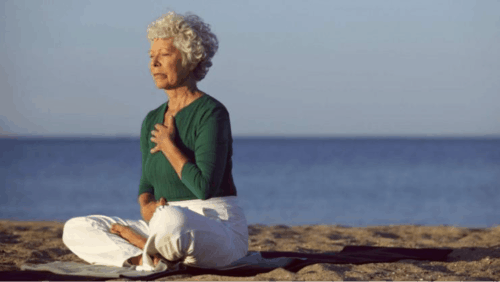
When was the last time you paused to take a deep breath? With coronavirus on everyone’s minds, now is a great time to focus on diaphragmatic breathing because it’s free, easy to do and is a proven method to boost your immune system (1). Added bonuses: studies show it helps improve cognition and balance (2, 3, 4). What’s not to love?
As I write this I am taking long, deep calming breaths in and out because this is something I can do right now to boost my health and immunity. Being proactive is empowering.
In these uncertain times, educating ourselves and taking steps to boost our immune system is a smart strategy. Deep or diaphragmatic breathing for a few minutes once or twice a day is a simple technique that anyone can do, anytime.
Immune Basics
The immune system is a network of cells, proteins, tissues and organs working together 24/7 to protect and heal from infection and injury. Piles of research demonstrate that chronic stress depresses the immune system (1). One way is that it decreases the body’s lymphocytes, the white blood cells that help fight off infections like viruses (5).
Fear & Stress
When we feel threatened or afraid, part of the brain called the amygdala is automatically alerted and tells our hypothalamus that we are in danger. At lightning speed, the hypothalamus talks to the rest of the body through the autonomic nervous system. This branch of the nervous system operates “automatic” processes like heart rate, blood pressure, respiration and digestion (6).
The sympathetic and parasympathetic are two parts of the autonomic nervous system. These networks operate on autopilot and react to the environment around you, including your thoughts. The body responds the same way to psychological stress as it does to physical stress.
When we perceive danger or feel afraid, the sympathetic nervous system turns on the “fight-flight-freeze” response. Stress hormones like adrenaline, norepinephrine and cortisol flood your body mobilizing immune cells along the way to react quickly to the threat; blood sugar spikes to provide quick energy, blood pressure and heart rate go up and non-essential functions like digestion slow or shut down. You can think of it as flooring the gas pedal of your car to avert imminent danger.
When we are out of danger the parasympathetic nervous system taps on the brakes and we can calm down and relax. This is when our body can rest, digest, heal and repair.
When we are chronically stressed and worried, we are living in a sympathetic state with our body staying revved up and on high alert. You may notice muscle tension, fatigue, joint aches, irritability, anxiety, depression and shallow breathing becoming the daily norm. The inflammatory response needed to protect us in an acute situation becomes chronic and disrupts almost all bodily processes.
This increases the risk of chronic conditions like heart disease, digestive problems, anxiety, sleep issues, depression and memory problems.
The bottom line is chronic stress leads to greater levels of inflammation and a decline in health and immunity. Today is a great day to explore healthy ways to cope with life’s stressors.
Breath Away Stress
Slow, deep breathing sends signals to the nervous system that the danger has passed and it’s okay to relax. That’s when stress hormones return to baseline levels and you feel calm again. It works because the diaphragm is connected to the autonomic nervous system. Slow, deep breathing shifts us into relaxation and restoration mode, where we should spend most of our time.
Diaphragmatic breathing is a deep breathing technique that uses the diaphragm, the main muscle of respiration. It’s located just below the lungs and heart (5) and is the floor of the thoracic/chest cavity and ceiling of the abdominal cavity.
Research shows that diaphragmatic breathing helps decrease anxiety, blood pressure and muscle tension while also enhancing balance (2,3,4). Essentially, it builds physical and mental resilience, and we can all use more of that right now.
Take a Breather!
Practice “ribcage” breathing a few minutes each day. Personally, I take 30 deep breaths before getting out of bed in the morning and before going to sleep. When I wake up in the middle of the night, I do the same deep breathing and then tell myself several times, “I am so sleepy;” followed by, “I am sleeping.” This puts me back to sleep 95% of the time which is great for a former insomniac!
Inhale Relaxation, Exhale Stress
- With shoulders relaxed, sit tall or lie on your back, placing a pillow under your knees for more comfort.
- Place one hand on your chest and the other on your stomach just below your ribcage.
- Take a slow, deep breath through your nose into your stomach and ribcage, feeling your belly rise and ribcage expand while the hand on your chest stays still.
- Exhale slowly and fully through your nose or mouth, tightening your stomach muscles. You can visualize bringing your belly button to the spine.
Diaphragmatic breathing is just one type of breathing technique. It’s important to find one that works best for you. Visit the American Lung Association or Lung Institute websites for more information and instruction.
The beauty of deep breathing is that you can do it any time you feel anxious, worried or are overwhelmed by anything. I’ve been practicing deep breathing for a few months now as a bedtime ritual and before meals saying a blessing of gratitude. On most days I practice 15-20 minutes of gentle yoga too. I’ve noticed that I am digesting my food better, sleeping deeper, am less irritable and more loveable!
Start your deep breathing practice today and let me know how it makes you feel. Remember, we are all in this together.
References
- Morey, JN et al (2015) Current Directions in Stress and Human Immune Function https://www.ncbi.nlm.nih.gov/pmc/articles/PMC4465119/
- Ma, X et al (2017). The Effect of Diaphragmatic Breathing on Attention, Negative Affect and Stress in Healthy Adults. https://www.ncbi.nlm.nih.gov/pmc/articles/PMC5455070/
- Kocjan, J et al (2018). Impact of diaphragm function parameters on balance maintenance. PLOS One https://journals.plos.org/plosone/article/file?id=10.1371/journal.pone.0208697&type=printable
- Lee, HJ et al (2018). Effects of diaphragm and deep abdominal muscle exercise on walking and balance ability in patients with hemiplegia due to stroke. https://www.ncbi.nlm.nih.gov/pmc/articles/PMC6165973/
- Cleveland Clinic (2017) What Happens When Your Immune System Gets Stressed Out? https://health.clevelandclinic.org/what-happens-when-your-immune-system-gets-stressed-out/
- Waxenbaum, JA & Varacallo M (2019). Anatomy, Autonomic Nervous System; https://www.ncbi.nlm.nih.gov/books/NBK539845/ https://www.health.harvard.edu/staying-healthy/understanding-the-stress-response

Cate Reade, MS, RD, is a Senior Fitness Expert and entrepreneur leading an epidemic of mobility. As CEO of Resistance Dynamics, she is delighted to be helping older adults regain strength, balance, and confidence with her innovation, the MoveMor™ Mobility Trainer and exercise programming. Over 10 independent studies show better balance, increased leg strength, greater ankle flexibility, increased independence, improved continence and a reduced fall risk – in as little as 10 minutes a week. Cate loves working with physical therapists, restorative nurses, fitness and senior living professionals who are looking for effective and simple ways to improve functional mobility and reduce fall risk so people can live more. Call Cate at 303.515.7070; Cate@MoveMor.com or visit MoveMor.com.

